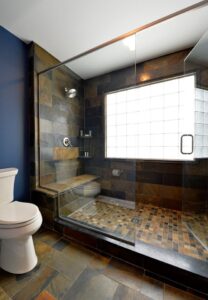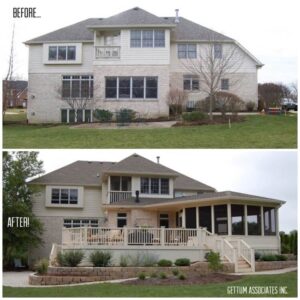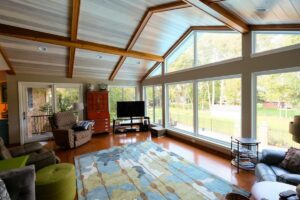The phrase “interior design” might bring to mind a change of drapes, a few new pieces of furniture, and a different color of paint on the walls. However, interior design as part of an interior home remodel can create dramatic change within your home that can refresh its appearance, improve its value, and increase the enjoyment you have in owning your home.
Whether you opt for a major remodel of your home with an entirely new style, or you simply upgrade your tired interior for a new, fresh look, you and your contractor have a variety of ways to ensure success in your new design. Here are a few topics to discuss as you begin planning the interior design change to your home.
Increase the Height of Your Rooms
One of the most noticeable changes to a space occurs when you make it larger. You can physically increase the size of a room by pushing a wall out or putting on an addition, or you can increase the height of the room to make everything feel a little more open and larger.
House Beautiful reveals:
“Create strong verticals and avoid the horizontal… [use] large mirrors because they add scale to a room.”
If you’re unable to put an addition onto your home, increasing the height of the room via moving the ceiling is one option, but you can also increase the perceived height by using mirrors, installing bigger windows. An even less expensive option is to fake the size of the windows by using long drapes that stretch from the top of the windows to the floor and make it appear as though you have floor to ceiling windows.
Increasing the height of the room may make the space feel more relaxing and open, and you can go about it through significant renovations, minor remodeling, or tricks of the eye. The choice is up to you and may depend on how much you have to spend.
Use Comfortable Furniture, Always
You may spend a significant amount of time talking about the interior design of your space and how features like the color palette, the materials used, and the placement of certain features will impact the final look of your space. However, it’s important that you don’t get caught up in making everything look “perfect” while you sacrifice the usability of your home.
A writer at Life Hack suggests great furniture can actually improve your mood:
“When you come home from a long day’s work, you may be cranky and irritable. There’s no better way to improve your mood than an adequately furnished house. A mix of comfort, color, and your overall taste and expression can be the best medicine to get you feeling better quickly. No matter what style you appreciate or what makes you feel happy, you have the perfect canvas in your house to promote soothing settings.”
Today’s furniture designers offer everything from beautiful couches that look so expensive that nobody would sit on them to plush, comfy couches that look like they’ve been in the family for a generation. Whatever your choice in the interior design of your furniture, it’s usually best to choose comfort as your primary goal. A living room isn’t a “living” room if you can’t enjoy it without worrying about wrinkling the material on the sofa.
The same wisdom applies to other areas of your home undergoing a redesign, renovation, or interior design update.
- The dining room: Make sure your dinner table chairs are comfortable. Avoid chairs that look like bar stools and tables that would only suit a seven-foot-tall basketball player (unless you’re a seven-foot-tall basketball player and enjoy dinner with similarly sized friends).
- The bathroom: Get a toilet seat lid you can sit on when it’s down that won’t buckle or move. With the lid down, your toilet seat is a convenient place to sit when you’re performing simple tasks like cutting toenails.
- The bedrooms: Humans spend anywhere from a quarter to a third of their lives sleeping, and a comfortable bed can have a dramatic impact on your health and well-being. Consider the extra money you spend on a nice bed today as insurance against illness tomorrow.
Consider Texture When You Consider Color
One of the first steps in creating a pleasing interior for your newly remodeled home is choosing your colors. With minimal research, you’ll realize that sticking to just one or two main colors and supporting those colors with one or two additional colors is quite enough as far as your color palette is concerned.
An interesting task you may wish to undertake in the early stages of your redesign is to consider how a particular texture might look in your home.
Freshome suggests:
“Texture is the thing that makes a room pop. It’s what brings a perfectly fine design up to enviable levels.”
A texture may provide as much impact as a color, so you may wish to include one of your textures as a primary or supporting “color” in the room. For example, perhaps you’re adding on a sunroom to your home, or you’re remodeling a room to feature large windows and skylights.
The wicker furniture you use will have a very distinct texture, and you can use that texture as one of your primary colors. Perhaps the wicker you use is an antiqued gray color, and your other colors in the room are cream and brown. Choose fabrics, carpet, and paint that support the intricate weave of the wicker.
Design/Build a New Room in Your Home with the Gettum Associates Team
Bringing a home remodeling plan from concept to reality takes knowledge and experience, and you’ll benefit from working with the design experts at Gettum Associates. If you’re interested in remodeling your home, but you’re not sure where to begin, our design/build services and home design expertise is the place to start. Get in touch with us today to arrange a design consultation, or give us a call at (317) 542-3853.















